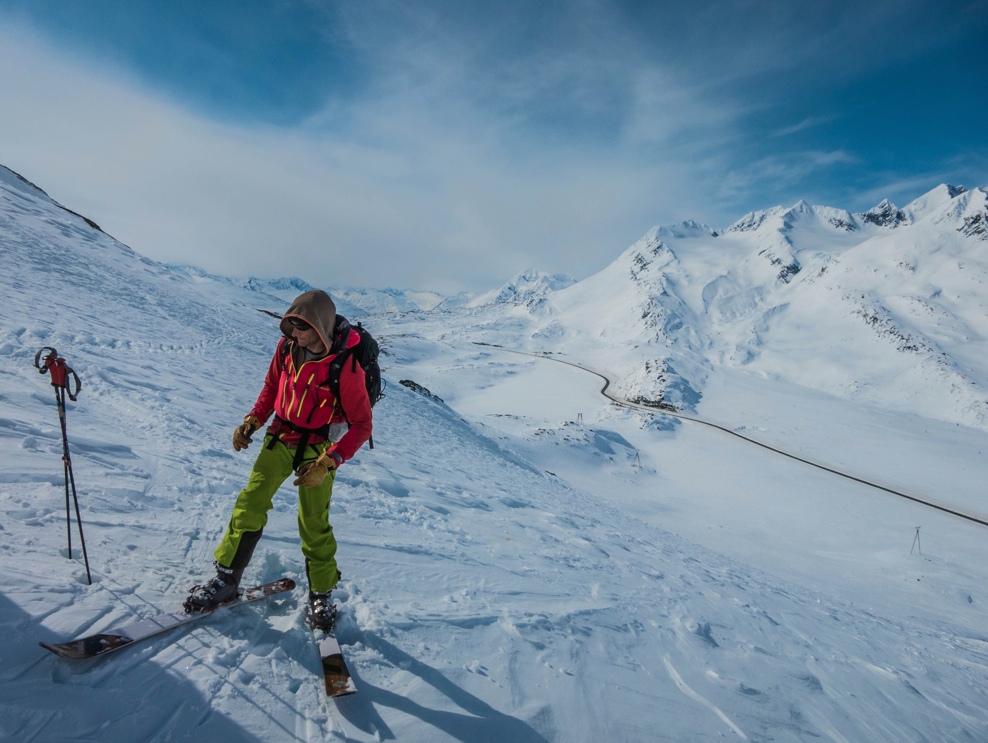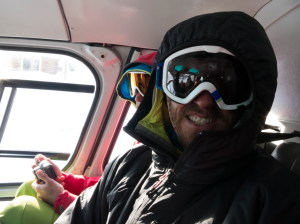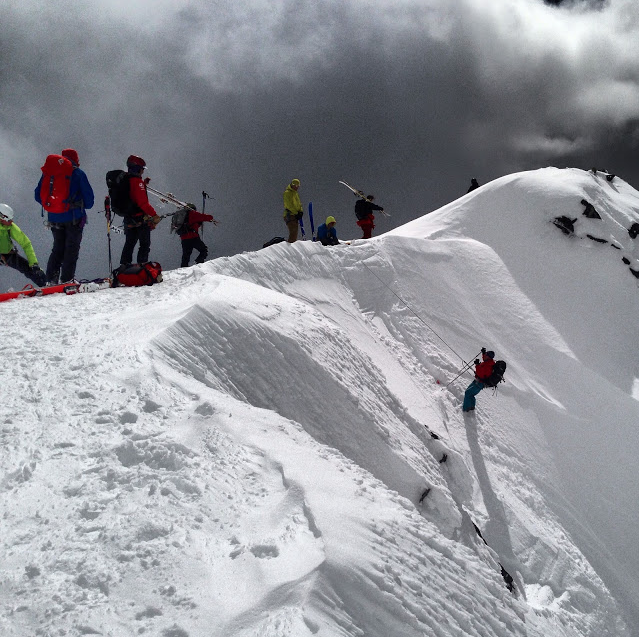Patrick Ormond on the Arc’teryx Scholarship & the 2013 Ski Mountaineering Guide Exam
 I wasn’t nervous going into this, my final exam. Having been through the Rock and Alpine disciplines, I figured this was old hat and there wasn’t any reason to get nervous. The rock exam had felt easy, but I almost let stress get the better of me on the last day of my alpine exam. I wasn’t going to let that happen this time and had done everything I could to prepare.
I wasn’t nervous going into this, my final exam. Having been through the Rock and Alpine disciplines, I figured this was old hat and there wasn’t any reason to get nervous. The rock exam had felt easy, but I almost let stress get the better of me on the last day of my alpine exam. I wasn’t going to let that happen this time and had done everything I could to prepare.
I lived in Park City, Utah, for almost ten years, and started guiding there. Skiing and guiding skiing are the things to do there in the winter. Now I live in Ouray, and ice is where it’s at. I went from guiding 95% skiing and 5% ice to just the opposite. My personal ski days were way down as well, partly because of the snowpack and partly because my wife is a fiend for ice and mixed climbing. The debriefs for both of my ski courses included the statements that I could ski well enough, but I should put down the ice tools to get ready for the exam.
 So that’s what I did this winter, although a dry early season tried my patience and finally killed my skis. Ordering a new pair must have sent the right message, because it started snowing at the end of January and kept on coming. I actually didn’t hit a rock the rest of the season until Alaska. No rocks to hit in Colorado! A typical sketchy Colorado snowpack meant keeping it mellow, and a 300’ ride in a small avy was a too close reminder of that. The guiding work was a steady mix of ice, skiing, and avy courses, and every other day was spent skiing, mostly in the Red Mountain Pass area. Come March, it was time to hit the road for some pre exam training, so I loaded up the Sprinter (Betty), and was off.
So that’s what I did this winter, although a dry early season tried my patience and finally killed my skis. Ordering a new pair must have sent the right message, because it started snowing at the end of January and kept on coming. I actually didn’t hit a rock the rest of the season until Alaska. No rocks to hit in Colorado! A typical sketchy Colorado snowpack meant keeping it mellow, and a 300’ ride in a small avy was a too close reminder of that. The guiding work was a steady mix of ice, skiing, and avy courses, and every other day was spent skiing, mostly in the Red Mountain Pass area. Come March, it was time to hit the road for some pre exam training, so I loaded up the Sprinter (Betty), and was off.
First stop was Jackson and co-guiding a ski descent of the Otterbody snowfield off the Grand Teton. Conditions were perfect and we skied the Middle Teton Glacier, the Pinocchio Couloir (58 degress), and then the Otterbody the next day. This was the first time that route had been guided, and we lucked out with powder off the summit. The Tetons offer some of the most technical ski mountaineering in North America, and are perfect training grounds for the ski exam.
Next stop was Valhalla Mountain Touring north of Nelson, B.C. Evan Stevens invites exam candidates to come up to the lodge for a week of exam prep. I’m not sure what others’ experiences have been in previous years when Evan was there, but it sounds pretty exam oriented. Since he blew his knee out earlier in the season, his wife Jasmin was running the show solo, and we just skied as much powder as was possible for seven days straight. That was perfect exam prep, and I was happy to run guests back and forth and break as much trail as I could. The group that week was a strong one, and the vertical added up quickly.
A quick stop back in the Tetons on the way home led to another attempt to ski the Grand with friends, this time shooting for the original Briggs route. The weather didn’t cooperate, but we still skied 5000‘ of great snow. Back home in San Juans, the snowpack had gained a lot of strength and the ski mountaineering season was on. It was still snowing, so powder on a solid base made for great conditions down the Snake Couloir off Mt. Sneffels. A couple of days out with Gary and Pi, two other exam candidates, finished up the training, and it was time to fly to Alaska.
 Gary and arrived in Valdez four days before the exam started, and that allowed us to figure out the area and for everyone in the exam to get out for a little more prep. We ran through technical systems and shared all the beta we could get. Some people were starting to show some nervousness, but I felt calm and always said so when asked. Even at the pre exam meeting, everything was cool, and I was almost surprised that I still felt no nerves.
Gary and arrived in Valdez four days before the exam started, and that allowed us to figure out the area and for everyone in the exam to get out for a little more prep. We ran through technical systems and shared all the beta we could get. Some people were starting to show some nervousness, but I felt calm and always said so when asked. Even at the pre exam meeting, everything was cool, and I was almost surprised that I still felt no nerves.
But driving to the trailhead on the first morning, I was stressed and nervous… so much for that plan. The wind had been howling on Thompson Pass the last couple days, and the snow was hammered. I was second in line for the day, meaning I would have the first descent. Where was I supposed to find good snow? As we hiked up the first climb, School Bus, everything was hollow hard wind slab and sastrugi. I took over near the top of the climb. I waffled a bit over the tour plan before changing the objective and heading towards the only sheltered slope in sight. Needless to say, the skiing sucked, but once I accepted that, my decision-making came around, and the nerves were gone.
Everyone had their moments under the gun and feeling the stress, and luckily I got mine out of the way early on. After that the rest of the exam was great. We had generally good conditions with a mostly stable snowpack. Past Valdez exams have been a little later in the season, and the conditions have been warmer and more spring like. We were still in winter conditions, with cold temps and dry snow. We skied steep and deep, booted a bunch of couloirs, and flew a couple of days in the heli, landing on some narrow ridges and tiny summits. The season of training paid off. I was strong on the up and down, and felt like I could have turned it up more.
 The most important part of the exam was not letting stress get the better of me. By accepting mistakes and quickly moving on, I was able to adjust and adapt during the exam and keep the learning process going. I have found through the whole certification process that remaining open to comments and critique is the key to not only passing, but also to coming out of the program having learned something. We don’t have many opportunities when working for honest peer review, and the certification process allows for that to happen with the daily debriefs. I found the informal in-the-car-ride home debrief as important as the formal debriefs with the examiners.
The most important part of the exam was not letting stress get the better of me. By accepting mistakes and quickly moving on, I was able to adjust and adapt during the exam and keep the learning process going. I have found through the whole certification process that remaining open to comments and critique is the key to not only passing, but also to coming out of the program having learned something. We don’t have many opportunities when working for honest peer review, and the certification process allows for that to happen with the daily debriefs. I found the informal in-the-car-ride home debrief as important as the formal debriefs with the examiners.
After a spring climbing trip, it’s time to get to work and put this pin to use! I would like to thank Arc’teryx and the AMGA for providing scholarship support
This Arc’teryx scholarship covers full tuition for an AMGA Ski Course or Exam. To qualify for this scholarship, you must meet the criteria outlined on the main Scholarship page and have three years of professional guiding experience.
Arc’teryx stays true to its snowy Canadian roots by providing a full tuition scholarship to an eligible student in the ski discipline. Our northern friends partnered with the AMGA in 1997, and continue their commitment on the Benefactor level. Additionally, Arc’teryx works with our sister organization, the Association of Canadian Mountain Guides (ACMG). By sponsoring the Round Table Discussion at the AMGA Annual Meeting, Arc’teryx provides a platform for AMGA members to gather and discuss important issues. Arc’teryx’s financial contributions fund a full tuition scholarship for an eligible candidate every year.













